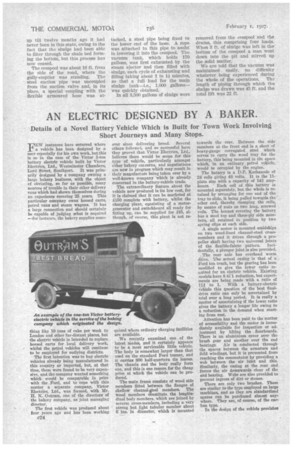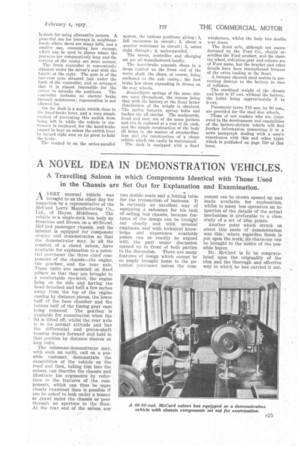AN ELECTRIC DESIGNED BY A BAKER.
Page 46

Page 47

If you've noticed an error in this article please click here to report it so we can fix it.
Details of a Novel Battery Vehicle Which is Built for Town Work Involving Short Journeys and Many Stops.
MIEW instances have occurred where a vehicle has been designed by a user especially for his own work, but this is so in the case of the Victor 1-ton battery electric vehicle built by Victor Electrics, Ltd., Westminster Chambers, Lord Street, Southport. It was primarily designed by a company owning a large bakery business, with the object of obviating, so far as possible, many sources of trouble in their other delivery vans which had shown themselves during an experience covering 25 years. This particular company owns horsed carts, petrol vans and steam wagons. It has a large connection and should certainly be capable of judging what is required —for instance, the bakery supplies some
thing like 10 tons of cake per week to London and other far-distant places, but the electric vehicle is intended to replace horsed carts for local delivery work, whilst the petrol vehicles will continue to be employed for outlying districts.
The first intention was to buy electric vehicles already being manufactured in this country or imported, but, at that time, these were found to be very expensive, and the company wanted something which would be comparable in price with the Ford, and to cope with this matter a separate company, Victor Flectrics, Ltd., was foimed, with Mr. 11. N. Outram, one of the directors of the bakery company, as joint managing director.
The first vehicle was produced about four years ago and has been working c24 ever since delivering bread. Several others followed, and so successful have they proved that Victor Electrics, Ltd., believes there would be scope for this type of vehicle, particularly amongst cther bakery cor.corns, and negotiations are now in progress which may result in their manufacture being taken over by a well-known company which is already Concerned in the battery-vehicle trade.
The extraordinary feature about the vehicle now produced is its low cost, for it is claimed that it can be marketed at £150 complete with battery, whilst the charging plant, consisting of a motorgenerator and switchboard all ready for fitting up. can be supplied for 145, although, of course, this plant is not re qnired where ordinary charging facilities are available.
We recently examined one of the latest modes, and it certainly appears to be a most serviceable little vehicle. The body is somewhat larger than that used on the standard Ford tomer, and it carries 800 half-quartern tin loaves. The chassis and the body really form one, and this is one reason for the cheap price at which the vehicle can be produced.
The main frame consists of wood side members fitted between the flanges of shallow channeliteel members. The wood members constitute the longitudinal body members, which are joined by severat cross-members, including a very strong but light tubular member about 6 ins. in diameter, which Is mounted towards the rear. Between the side members at the front end is a sheet of heavy-gauge corrugated steel which serves to carry the wood tray for the battery, this being mounted in the space which, in an ordinary petrol vehicle, would be occupied by the engine.
The battery is a D.P. Kathanode of 24 cells giving 48 volts. It is the 11plate size with a capacity of 143 amp
hours. Each cell of this battery is mounted separately, but the whole is retained by arranging for one end of the tray to slide, it being pulled towards the other end, thereby clamping the cells, by means of nuts on two long, screwed rods. The bonnet covering the battery has a steel top and three-ply side members, all retained in position by two spring clips at each side.
A single motor is mounted amidships on two wood-lined channel-steel crossmembers and it drives through a propeller shaft having two universal joints of the flexible-fabric pattern. Incidentally, a plunger joint is also provided. , The rear axle has overhead worm drive. `.ile actual casing is that of a Ford ton track, but the gearing has been modified to give the lower ratio required for an electric vehicle. Existing models have 8 tól reduction, but experiments are being made with a ratio of to 1. With a battery-electric vehicle this question of the best finaldrive ratio can only be ascertained by trial over a long period. It is really B, matter of ascertaining if the lower ratio gives the battery a longer life owing to a reduction in the demand when starting from rest.
Attention has been paid to the matter of accessibility and the motor is immediately available for inspection or adjustment by lifting the floorboards. There is an aluminium cover over the brush gear and another over the end bearings. Air is condncted through the spaces between the armature and field windings, but it is prevented from reaching the commutator by providing a web between the air inlet and this. Similarly, the casing at the rear end forces the air downwards clear of the end beating. Webs are also provided to prevent ingress of dirt or stones.
There are only two brushes. These are similar to the type employed on large machines, and as they are standardized spares can be purchased almost anywhere. They are, of course, of the carbon type.
In the design of the vehicle provision
is made for using alternative motors. A powerful one for journeys in neighbourhoods where there are many hills, and a smaller one, consuming less current, 'Which can be used in places where the journeys are comparatively long and the contour of the routes are more normal.
The drum controller is conveniently situated under the driver's seat with the handle at the right. The gate is of the iace-carn tyPe eituated just under the knob of the controller, and so arranged that it is almost impossible for the driver to mistake the positions. The vontreller includes an electric brake through resistances; regeneration is not allowed for.
On the dash is a main switch close to the hand-brake lever,. and a very simple method of preventing this switch from being left in while the vehicle is stationary is employed, for the hand-brake cannot be kept on unless the switch lever be turned right Over on its pivot to hold the brake.
The control is. on the series-parallel system, the various positions giving: 1, full resistance in circuit ; 2, about a quarter resistance in circuit ; 3, series right through ; 4, series-parallel.
The motor, controller and charging set are all manufactured locally.
The hand-brake expands shoes in a drum carried on the front end of the worm shaft, the shoes, of course, being_ anchored to the axle casing ; the foot brake has shoes expanding in drums on the rear wheels.
Semi-elliptic springs of the same size are used throughout, the reason being that with the battery at the front better distribution of the weight is obtained. The spring hangers, spring bolts and bushes are all similar. The mudguards, front and rear, are of the same pattern and can be replaced at a cost of Ss. each, ' and the simple construction of the body all helps in the matter of • standardization and the construction of a cheap vehicle which can easily be maintained.
The dash is equipped with a fixed windscreen, whilst the body has double rear doors.
The front axle, although not manufactured by the Ford Co., closely resembles the Ford product, and the steering wheel, reduction gear and column are of Ford make, but the bracket and other details have been strengthened because of the extra loading at the front.
A bumper channel steel assists in preventing damage to the battery in case of collision.
The combined weight of the chassis and body is 17 cwt. without the battery, the latter being approximately 5 to 0 cwt.
Pneumatic tyres, 710 mm. by 90 mm., are provided for the steel disc wheels. Those of our readers who are interested in the development and capabilities -of the battery-electric vehicle will find further information concerning it in a news paragraph dealing with a user's experiences with this and other types which is published on page 750 of this issue.


































































































